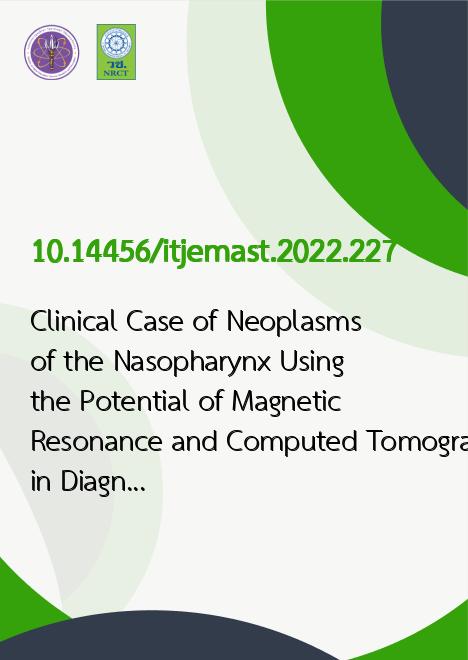
|
Clinical Case of Neoplasms of the Nasopharynx Using the Potential of Magnetic Resonance and Computed Tomography in Diagnosis and Staging |
|---|---|
| รหัสดีโอไอ | |
| Creator | Luiza Magometovna Marzieva, Malika Tausovna Amaeva, Kyamran Shavkatovich Davrushev, Arzu Geray kizi Alieva, Aslan Fatulakhovich Salmanov, Islam Kazbekovich Abdurakhmanov, Arsen Abuzagirovich Adzhimuradov, Lilita Movlievna Tsoroeva, Emir-Han Mohadievich Hajmuradov, Adilkhan Zalimkhanovich Cherivmurzaev, Zaynitdin Abdulvagabovic Imakov |
| Title | Clinical Case of Neoplasms of the Nasopharynx Using the Potential of Magnetic Resonance and Computed Tomography in Diagnosis and Staging |
| Contributor | - |
| Publisher | TuEngr Group |
| Publication Year | 2565 |
| Journal Title | International Transaction Journal of Engineering, Management, & Applied Sciences & Technologies |
| Journal Vol. | 13 |
| Journal No. | 11 |
| Page no. | 13A11Q: 1-9 |
| Keyword | MRI, CT, Staging, Cancer, Diagnostics |
| URL Website | http://TuEngr.com/Vol13-11.html |
| Website title | ITJEMAST V13(11) 2022 @ TuEngr.com |
| ISSN | 2228-9860 |
| Abstract | The incidence of nasopharyngeal carcinoma of the nasopharynx in Russia in 2021 was 0.73 cases, and the mortality rate was 0.27 cases per 100,000 population, while the incidence in men is 6.3 times higher than in women. Nasopharyngeal carcinoma is one of the oncological diseases, often asymptomatic and debuting with the appearance of cervical lymphadenopathy. Conducting a comprehensive radiation examination of the patient (a combination of magnetic resonance imaging and computed tomography), allows for a full-fledged local staging of the pathological process in nasopharyngeal carcinoma. To identify the primary focus and local staging, radiation examination methods are used, in particular, computed tomography and magnetic resonance imaging (MRI, staging according to the T and N criteria). Positron emission tomography (CT, staging according to criterion M) is used to identify distant lesions. This article presents a clinical case of diagnosis of enlarged cervical lymph nodes with detected squamous cell carcinoma. The patient was referred for radiation examination in order to determine the localization of the primary focus and local staging (CT, MRI). The results of the examination allowed us to draw conclusions about the importance of conducting a comprehensive radiation examination and the correct staging of the process to determine the optimal zone for radiation therapy. |